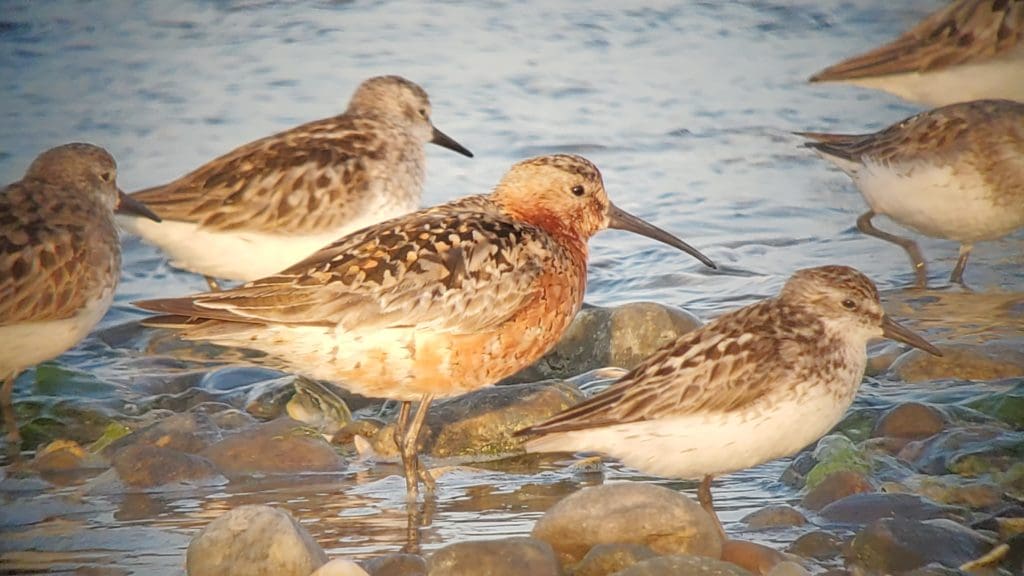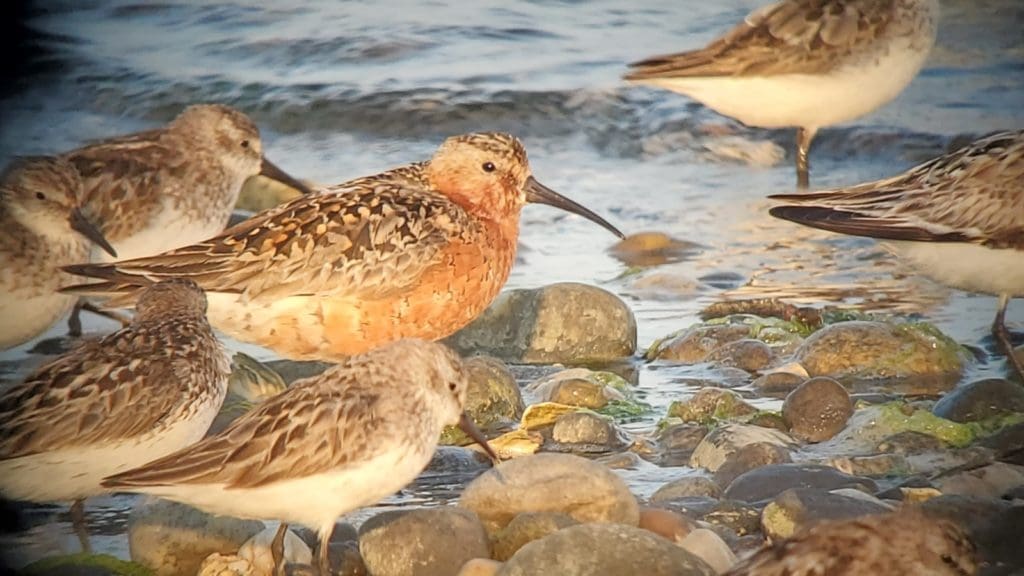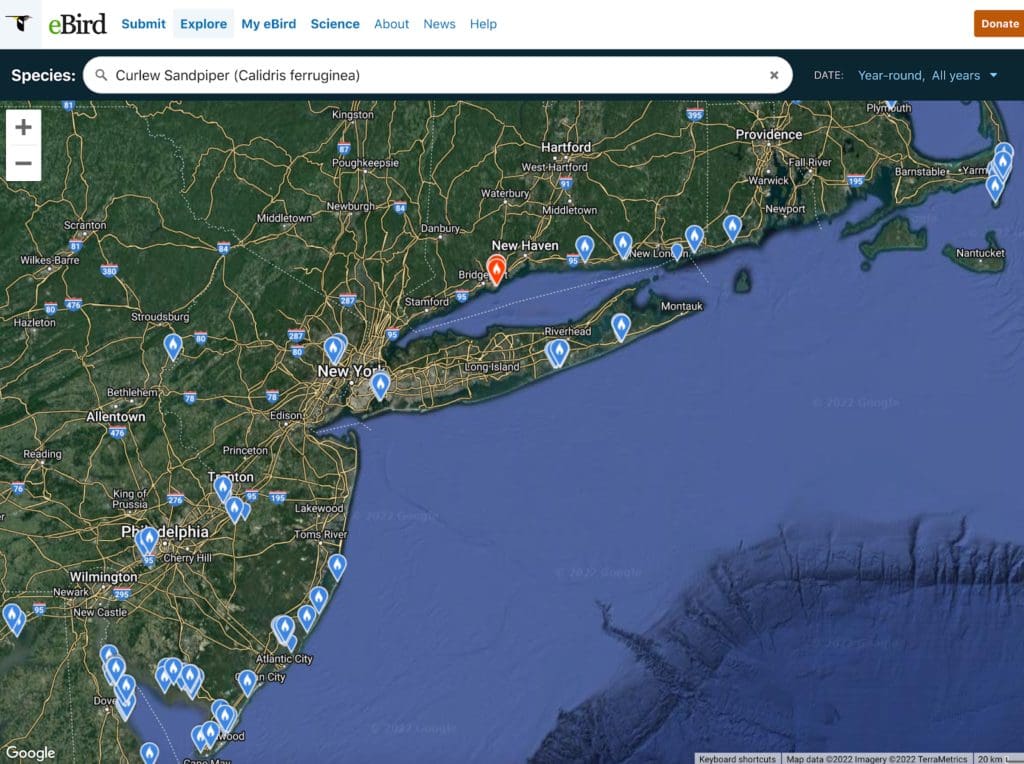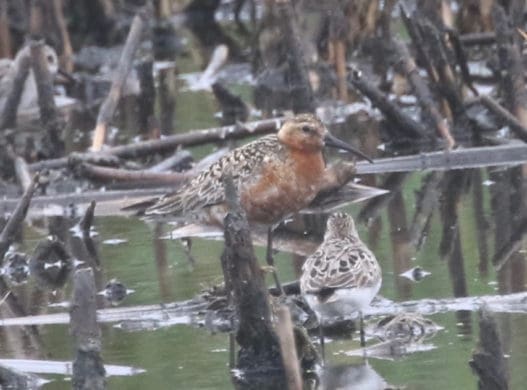Curlew Sandpiper
Curlew Sandpiper, Stratford, CT, 7/18/2022. Photo by Frank Mantlik
Very few bird species could top Curlew Sandpiper (CUSA) as the best rare bird of the month of July in Connecticut this year.
Frank Mantlik found it on July 18th, and recently noted that this CUSA is the only one currently in the USA and Canada. (Photo above is the first sighting of the Curlew Sandpiper with a Semipalmated Sandpiper in Short Beach Park golf course, Stratford, Connecticut, USA. 18 July 2022. © Frank Mantlik)
This Curlew Sandpiper is not only the Bird-Of-The-Month in Connecticut for July, it is also probably the front runner for Bird-Of-The-Year in CT. Let’s see if any other rare (and chaseable) bird can surpass this CUSA by the end of this year.
Here are several July 21 photos of this Curlew Sandpiper, the first two by Frank Mantlik (https://www.flickr.com/photos/avocetfm/ ) and the next three by Steve Hubbard (https://www.flickr.com/gp/30264683@N07/52G6M21808 ).


Note the gradually and continuously decurved bill, the long body shape, the long upswept tail section, the long legs — longer than Dunlin legs, and a very useful field mark when scanning large flocks of shorebirds. The CUSA in any plumage stands out as a taller bird (note Frank Gallo’s comparison with Semipalmated Sandpipers below).


STATE YEAR LIST for Connecticut 2022
This CUSA is the 304th bird species reported to eBird in Connecticut this year. The other new species added in July were Western Sandpiper, Stilt Sandpiper, American Avocet, Forster’s Tern, Royal Tern and Franklin’s Gull.

ARCC UPDATE from Phil Rusch
There are currently seven accepted records of Curlew Sandpiper in Connecticut, one unaccepted record, and eight records that have not been reviewed. The current individual falls into the latter category for now.
The oldest ACCEPTED state record was a CUSA found by Davis Finch at Broad Brook Reservoir in Cheshire on 25 October 1965. An exceedingly rare inland record.
At least two of the un-reviewed records pre-date the Cheshire record.
The last chase-able bird was from October of 1998 in Old Lyme. That individual stayed for 5 days.
The longest staying individual was for a whopping 36 days from 6 June -11 July of 1971. This bird really moved around as it was recorded in New Haven, West Haven, and Milford. Again Davis Finch was involved as he got the first photographic record for the species. This individual falls into the not reviewed category, which ARCC is working on.
Note that Frank Mantlik has seen four of these CUSA in CT, and found two of them: this current bird plus a CUSA in May 1981 at Milford Point. Thank you again Frank. More than one hundred birders are estimated to have seen this current CUSA.
eBird Maps


Manually exploring eBird maps for all of the Western Hemisphere, from Arctic to Antarctic, showed no other CUSAs reported during this recent time period, June 21 through July 21. Connecticut has the only one!
Zooming out even further, to show the entire planet, we note that the map below uses pink blocks to indicate all the CUSA sightings ever reported to eBird, not just recent reports. Exploring eBird further we did find some recent CUSA sightings in Europe and Asia, especially in China, but have not included detailed maps for those.
REFERENCES
Wikipedia: Curlew Sandpiper:
https://en.wikipedia.org/wiki/Curlew_sandpiper and
https://en.wikipedia.org/wiki/Curlew_sandpiper#/media/File:Calidris_ferruginea_map.svg
eBird article on Curlew Sandpiper::
https://ebird.org/species/cursan/US-CT
Status and origins of Curlew Sandpipers in New York State, The Kingbird 2001, March. Angus Wilson. An excellent article by a well known seabirder.
https://nybirds.org/KBsearch/y2001v51n1/y2001v51n1p460-477wilson.pdf#search=%22robben%22
Nature Notes: 2011 May 13-14 Southern New Jersey:
Some of the best locations for occasional Curlew Sandpipers: Delaware Bay, both sides, including the remarkable Matts Landing.
Avibase:
https://avibase.bsc-eoc.org/species.jsp?lang=EN&avibaseid=143A681C9BCE9A20
Audubon Guide to North American Birds:
https://www.audubon.org/field-guide/bird/curlew-sandpiper
“A few Curlew Sandpipers turn up on the Atlantic Coast every year, rewarding birders who scan through the shorebird flocks. Elsewhere in North America, this Eurasian wader is only a rare visitor. It has nested at Point Barrow, Alaska, but in most years it is completely absent there.”
Birds Of The World link, regarding diet of this species:
https://birdsoftheworld.org/bow/species/cursan/cur/introduction
Including this about their diet,
++++++++++++++++++++++++++++++++
“Diet and Foraging:
On breeding grounds , mainly insects, including adults, pupae and larvae, especially of Diptera and beetles; also bugs and leeches. Feeds by pecking and probing in wet marsh and peat. Outside breeding season, mainly polychaete worms, molluscs, crustaceans, such as amphipods, shrimps and copepods, and sometimes insects; occasionally seeds. Picks prey from mud or sand surface or probes in mud (rarely inserting bill more than halfway) (1), regularly wading in shallow water (but deeper than C. alpina) (1); worms usually washed before being eaten. Diurnal and nocturnal. Gregarious outside breeding season, in flocks of up to several thousand.”
++++++++++++++++++++++++++++++++
Crossley ID Guides online:
CREDITS / CO-AUTHORS
This report is a product of the COA Seasonality Project, a team consisting of A.Dasinger, C.Ehlinger, R.Gedney, D.Jernigan, C.Repasz, and co-chaired by M.Bull and T.Robben. It is advised by ARCC: specifically by F.Mantlik, F.Gallo, P.Rusch, G.Hanisek.

